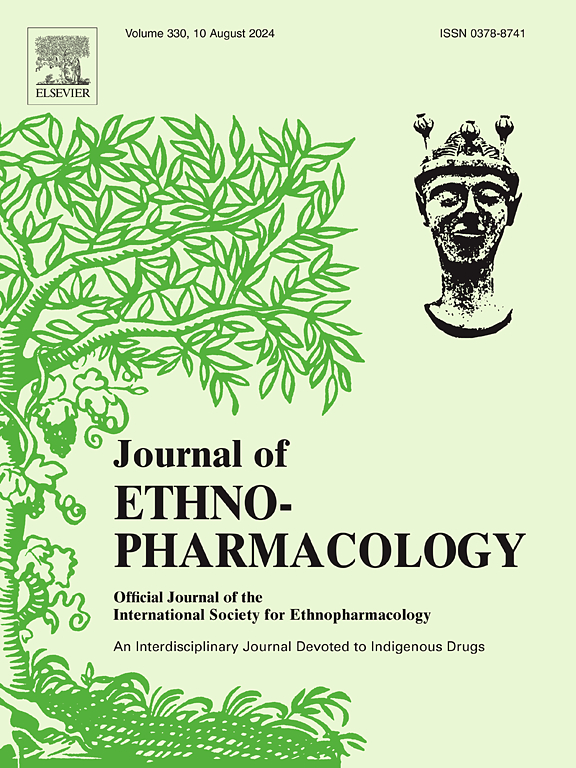通过综合药理学、多机器学习、人工智能和体外实验研究金银花防治非小细胞肺癌的机制
IF 4.8
2区 医学
Q1 CHEMISTRY, MEDICINAL
引用次数: 0
摘要
辣椒科(Caprifoliaceae,简称LJF)是一种药食同源的草本植物,因其清热、解毒和抗癌的特性而被传统地利用。然而,LJF辅助非小细胞肺癌(NSCLC)治疗的机制尚不清楚。目的通过植物化学分析、网络药理学、机器学习和体外实验验证等手段,阐明LJF治疗NSCLC的潜在机制。材料与方法采用超高效液相色谱-串联质谱法(UPLC-MS/MS)对sljf中的成分进行分析。LJF的活性化合物和靶点从TCMSP中鉴定,nsclc相关靶点从GeneCards、DisGeNET和OMIM中检索。网络药理学和多机器学习算法预测关键特征,GSEA/GSVA评估通路富集。免疫浸润分析评估NSCLC微环境中的免疫细胞组成,并与AlphaFold进行分子对接。体外实验评估LJF对A549细胞的影响,Western blot分析蛋白表达。结果网络药理学和多机器学习结果表明,PECAM1和SPP1是LJF治疗NSCLC的潜在靶点。GSEA和免疫浸润分析提示PECAM1和SPP1影响NSCLC的进展和免疫逃避。体外实验表明,LJF能显著抑制A549细胞的增殖、迁移和侵袭。Western blot结果显示,在LJF处理下,PECAM1和SPP1的表达上调。结论ljf通过调节PECAM1和SPP1靶点及其相关信号通路,对NSCLC具有辅助治疗作用。本文章由计算机程序翻译,如有差异,请以英文原文为准。

Mechanistic study of Lonicerae Japonicae Flos (Caprifoliaceae) in non-small cell lung cancer prevention and treatment through integrative pharmacology, multi-machine learning, artificial intelligence, and in vitro experiments
Ethnopharmacological relevance
Lonicerae Japonicae Flos (Caprifoliaceae) (LJF), an herb with the homology of medicine and food, is traditionally utilized for its heat-clearing, detoxifying, and anticancer properties. Yet, the mechanism by which LJF may assist in the treatment of non-small cell lung cancer (NSCLC) remains unclear.
Aim of the study
To elucidate the potential mechanisms of LJF in the treatment of NSCLC through phytochemical analysis, network pharmacology, machine learning, and in vitro experimental validation.
Materials and methods
LJF was analyzed for its components using ultra-performance liquid chromatography coupled with tandem mass spectrometry (UPLC-MS/MS). The active compounds and targets of LJF were identified from TCMSP, and NSCLC-related targets were retrieved from GeneCards, DisGeNET and OMIM. Network pharmacology and multi-machine learning algorithms predicted key features, and GSEA/GSVA assessed pathway enrichment. Immune infiltration analysis evaluated immune cell composition in the NSCLC microenvironment, and molecular docking was performed with AlphaFold. In vitro experiments assessed LJF's effects on A549 cells, and Western blot analyzed protein expression.
Results
Network pharmacology and multi-machine learning indicated that PECAM1 and SPP1 are potential targets for LJF in the treatment of NSCLC. GSEA and immune infiltration analysis suggested PECAM1 and SPP1 influence NSCLC progression and immune evasion. In vitro experiments showed that LJF significantly inhibited A549 cells proliferation, migration, and invasion. Western blot results indicated upregulation of PECAM1 and SPP1 expression under LJF treatment.
Conclusion
LJF has an adjunctive therapeutic effect on NSCLC by regulating PECAM1 and SPP1 targets and their associated signaling pathways.
求助全文
通过发布文献求助,成功后即可免费获取论文全文。
去求助
来源期刊

Journal of ethnopharmacology
医学-全科医学与补充医学
CiteScore
10.30
自引率
5.60%
发文量
967
审稿时长
77 days
期刊介绍:
The Journal of Ethnopharmacology is dedicated to the exchange of information and understandings about people''s use of plants, fungi, animals, microorganisms and minerals and their biological and pharmacological effects based on the principles established through international conventions. Early people confronted with illness and disease, discovered a wealth of useful therapeutic agents in the plant and animal kingdoms. The empirical knowledge of these medicinal substances and their toxic potential was passed on by oral tradition and sometimes recorded in herbals and other texts on materia medica. Many valuable drugs of today (e.g., atropine, ephedrine, tubocurarine, digoxin, reserpine) came into use through the study of indigenous remedies. Chemists continue to use plant-derived drugs (e.g., morphine, taxol, physostigmine, quinidine, emetine) as prototypes in their attempts to develop more effective and less toxic medicinals.
 求助内容:
求助内容: 应助结果提醒方式:
应助结果提醒方式:


